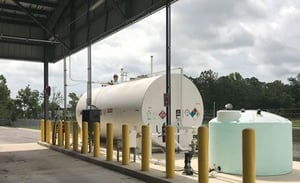No matter what type of shipping option you use, there’s one fact everyone learns pretty quickly – fuel surcharges can add up in a hurry.
 Fuel surcharges are tacked on to shipments by carriers to balance the fluctuating costs of fuel. This can become a problem for shippers, because it takes time and attention to fully understand them. Additionally, the way they are applied can vary significantly between carriers, which only complicates the issue more.
Fuel surcharges are tacked on to shipments by carriers to balance the fluctuating costs of fuel. This can become a problem for shippers, because it takes time and attention to fully understand them. Additionally, the way they are applied can vary significantly between carriers, which only complicates the issue more.
In this article we’ll look at these surcharges and discuss how even something so universal is subject to a number of different factors.
Why Do Fuel Surcharges Exist In The First Place?
Fuel makes up a large share of the cost of transporting goods by truck. Since the cost of fuel changes almost by the hour, and contracts are locked in months or years in advance, a fuel surcharge is a way for carriers to account for variations in fuel prices.
When Did Fuel Surcharges Begin?
They actually began in 1973 as a result of the Arab oil embargo. At that time, the Department of Energy began tallying a National Retail Diesel Average, which was meant to help compensate carriers who were being impacted by the dramatic fuel price fluctuations caused by the crisis.
Once prices steadied, these surcharges were actually removed. However, they returned again in the late '90s when diesel prices rose sharply. They’ve been a factor in overall shipping costs ever since.
How Are They Determined?
 Each carrier has its own formula for calculating surcharges. They’re normally added to the total freight charge on either a per-mile or percentage basis. These methods replace the 15% flat fee set up by the Department of Energy in the '70s. That flat fee was based on the total linehaul charge and caused massive overpaying by shippers of high-value goods. It was later abandoned. Today, these are often based on an average mile per gallon and the national average price of diesel.
Each carrier has its own formula for calculating surcharges. They’re normally added to the total freight charge on either a per-mile or percentage basis. These methods replace the 15% flat fee set up by the Department of Energy in the '70s. That flat fee was based on the total linehaul charge and caused massive overpaying by shippers of high-value goods. It was later abandoned. Today, these are often based on an average mile per gallon and the national average price of diesel.
Many carriers determine their fuel surcharge according to the National Average Diesel Fuel Index, published weekly by the Energy Information Administration (EIA). This Index collects retail pricing information from fuel stations throughout the United States, and creates a national average.
Part of the confusion surrounding fuel surcharges comes from the fact that not all carriers use the same information to arrive at their numbers. For instance, some rely on a separate EIA program that determines average retail prices based on regional geography, as opposed to national averages.
 In this system, the country is broken into five regions, called “Petroleum Administration for Defense Districts,” or PADDs. In case you’re wondering, the “Defense” is a reference to gas rationing during World War II, which is when the PADDs were established. By carving the country into these five distinct regions, the EIA is able to analyze not only pricing, but also petroleum movements over time.
In this system, the country is broken into five regions, called “Petroleum Administration for Defense Districts,” or PADDs. In case you’re wondering, the “Defense” is a reference to gas rationing during World War II, which is when the PADDs were established. By carving the country into these five distinct regions, the EIA is able to analyze not only pricing, but also petroleum movements over time.
Most carriers use one of these two EIA approaches in their fuel pricing formulas. That said, the EIA doesn’t establish or regulate fuel surcharges. They merely provide the raw information. Each carrier privately negotiates their own terms, which helps explain the variation in surcharges between carriers.
The Bottom Line.
Fuel surcharges are a valuable tool for carriers to protect themselves against fuel price increases over the life of a contract. At the same time, they’re also a factor that can greatly impact overall shipping costs. Knowing how they work is essential in fully understanding your cost of operations.










